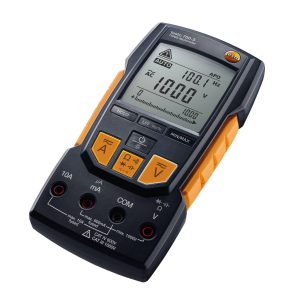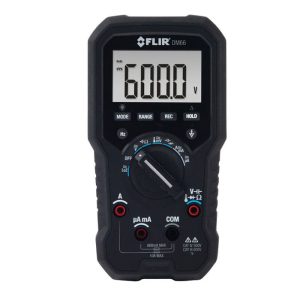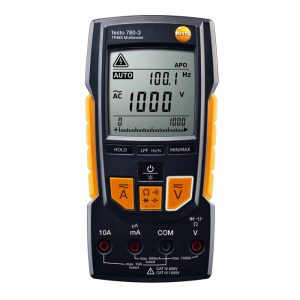The electrical parameters voltage, current, resistance, capacitance, frequency, and temperature can all be measured using a digital multimeter.
It is a necessary tool for electricians, technicians, engineers, enthusiasts, and students, among others who work with electricity.
However, how do you pick the ideal digital multimeter for your requirements? There are several things to think about, including the multimeter’s features, specifications, cost, and quality.
The testo 760-3 and the FLIR DM66, two well-liked digital multimeters from the website:mme-ae.com, will be contrasted in this article.
We will point out their similarities and differences and provide you with some advice on how to choose wisely.

760-3 Digital Multimeter by Testo
The testo 760-3 is a digital multimeter that differs from conventional multimeters in a few important ways. By using the socket assignment, it automatically determines the proper measurement parameter, so you don’t have to worry about bad settings or errors that could be dangerous.
Additionally, it can be operated easily with one hand thanks to illuminated function keys in place of a dial. Because of this, using and controlling it just requires one hand.
The testo 760-3 features a true root mean square measurement (TRMS), low-pass filter, and temperature adaptor in addition to a voltage range of up to 1,000 V.
Regardless of the form or frequency of an alternating current (AC), or voltage, TRMS is a feature that can measure its effective value. Compared to average or peak readings, this yields more precise data.
An element that can remove high-frequency noise or interference from the measuring signal is a low-pass filter. Measurements on frequency converter-controlled motors, which are frequently employed in industrial applications, may become more accurate as a result.
A feature that allows for the use of a thermocouple probe to monitor temperature is called a temperature adaptor. The temperature of electrical components or circuits can be determined using this.
Multimeter FLIR DM66 TRMS
Another digital multimeter that provides accurate and trustworthy measurements is the FLIR DM66. For measuring voltage and frequency on complicated equipment, it offers a TRMS feature in addition to a low impedance (LoZ) mode and a variable frequency drive (VFD) mode.
In order to get rid of ghost voltages, the multimeter’s LoZ feature can lower its input impedance. When testing open or disconnected circuits that are impacted by surrounding live wires or equipment, ghost voltages—false readings—can happen.
Variable speed drives, which regulate the speed of electric motors by adjusting the frequency of the power supply, have a mode that can measure voltage and frequency. This might be helpful for evaluating the effectiveness and functionality of various gadgets.
Additionally, the FLIR DM66 has a min/max/avg recording function and a continuity/diode test function. When there is low resistance, a continuity test function can detect whether there is an electrical connection between two places by issuing an audible beep.
A diode test is a feature that measures a diode’s forward voltage drop to see if it is functioning properly. The ability to record the minimum, maximum, and average values of a measurement across time is known as a min/max/avg recording feature. Monitoring trends or variations in the measuring signal may be possible with this.
A limited lifetime warranty and a temperature range of -40°C to 400°C are features of the FLIR DM66. A warranty is a promise from the manufacturer that, if the product fails because of flaws in the materials or the craftsmanship within a specific time frame, they will either fix it or replace it.
Differences and Similarities
Both multimeters can be used for a variety of tasks, including electrical installation, troubleshooting, upkeep, and repair. In terms of current, resistance, capacitance, and frequency ranges, they share identical specs.
Additionally, they both have Cat III 600V and Cat IV 300V safety ratings. These ratings show the highest voltage that the multimeter can measure safely in various electrical settings.
There are certain distinctions, though, that may affect your choice. Testo 760-3’s 1,000 V vs. FLIR DM66’s 600 V greater voltage range may be advantageous in some high-voltage applications.
A low-pass filter on the Testo 760-3 helps increase the precision of measurements on frequency converter-controlled motors. The FLIR DM66, on the other hand, offers a VFD mode that can detect voltage and frequency on variable speed drives and a LoZ mode that can remove ghost voltages.
Additionally, the FLIR DM66 has a wider temperature range (-20°C to 500°C vs. -40°C to 400°C) than the testo the testo 760-3, which may be significant for some thermal applications.
How to Choose the Right Action
In conclusion, both multimeters are great options for precisely and consistently measuring electrical parameters. You might, however, find one of them to be more appropriate than the other, based on your own needs and tastes. Here are some pointers on how to choose wisely:
Organize your finances. The price difference between the FLIR DM66 and the Testo 760-3 could influence your decision. On the website me-ae.com or other online marketplaces, you may compare the costs of these goods. You should also take into account the price of extras like probes, leads, batteries, and casings.
Think about your submission. The FLIR DM66 and the Testo 760-3 each have unique features and functions that may or may not be beneficial to your application. You should consider the types of measurements you must make, the instruments or circuits you must test, and the working environment you must use.
To make sure the multimeters match your needs, you should also check their specs and accuracy.
Think about your own preferences. The designs and user interfaces of the FLIR DM66 and the Testo 760-3 may or may not be more or less appealing to you.
Try to acquire a sense of how the multimeters work, how they feel in your hand, how simple it is to read and use them, and how cozy it is to work with them. For more information, you may also browse user reviews or get in touch with the vendor.
Click on the link below to go to the product page if you’re interested in purchasing something from this website. More details about the product, including its features, attributes, cost, and availability, are available there.
Additionally, you can add the item to your shopping cart and continue shopping. Please feel free to visit our website at mme-ae.com if you have any questions or comments. We appreciate your interest.
You can click the link below to view the product specifics if you want to purchase a digital multimeter from this website.
You may contrast the testo 760-3 and the FLIR DM66‘s features, characteristics, and costs to see which best meets your needs.
Additionally, you can order online and benefit from a quick and secure delivery. Visit our website at mme-ae.com or send us an email at [mme.sales.uae@gmail.com] if you need any help or have any feedback. We value your patronage.
The electrical parameters voltage, current, resistance, capacitance, frequency, and temperature can all be measured using a digital multimeter. It is a necessary tool for electricians, technicians, engineers, enthusiasts, and students, among others who work with electricity.
However, how do you pick the ideal digital multimeter for your requirements? In this post, we’ve compared the testo 760-3 and the FLIR DM66, two well-liked digital multimeters from the website mme-ae.com. We have outlined their similarities and differences and provided you with some advice on how to choose wisely.
Both multimeters can be used for a variety of tasks, including electrical installation, troubleshooting, upkeep, and repair. In terms of current, resistance, capacitance, and frequency ranges, they share identical specs.
Additionally, they both have Cat III 600V and Cat IV 300V safety ratings. There are certain distinctions, though, that may affect your choice. Testo 760-3’s 1,000 V vs.
FLIR DM66’s 600 V greater voltage range may be advantageous in some high-voltage applications. A low-pass filter on the Testo 760-3 helps increase the precision of measurements on frequency converter-controlled motors.
The FLIR DM66, on the other hand, offers a VFD mode that can detect voltage and frequency on variable speed drives and a LoZ mode that can remove ghost voltages. For some thermal applications, the FLIR DM66’s larger temperature range (-40°C to 400°C vs. -20°C to 500°C) over the Testo 760-3 may be crucial.
You should take your budget, application, and preferences into account to select the greatest choice. On mme-ae.com or other online marketplaces, you should contrast the costs of these goods.
To make sure the multimeters match your needs, you should also check their specs and accuracy. Additionally, you should try to acquire a sense of how the multimeters work, how they feel in your hand, how simple it is to read and use them, and how at ease they are to use while working. For further information, you should also check customer reviews or get in touch with the vendor.
We wish you pleasant measuring and hope this essay has helped you make an informed choice. Please feel free to contact us at [mme.sales.uae@gmail.com] or visit our website at mme-ae.com if you have any questions or comments. I appreciate you reading.




